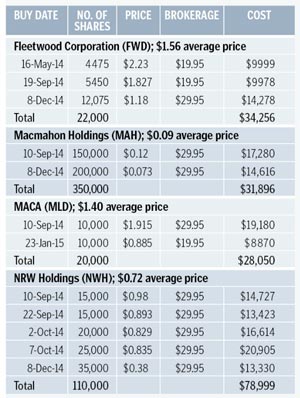Where experts invest: lessons from a $73,000 loss
By Greg Hoffman
Contrarian investors shouldn't panic when prices fall - but focus on long-term value
I am throwing open the books of one of the portfolios I run. I always find it interesting to see where experts invest (which often contrasts with what they say).
Let's start with the most important issue: risk. My investing objective is to put together a group of underpriced stocks that are not so similar that the overall portfolio could be significantly hurt by a single event or risk factor.
In practice, this means limiting purchases of stocks that I believe are deeply underpriced if I feel overexposed to any given risk.
In the case of mining services stocks, industry-wide risks include Chinese demand for commodities, commodity prices, the Australian dollar and the cost of labour, among others. I also consider company-specific factors such as debt levels and exposure to certain commodities or clients (there's a big difference between servicing high- and low-cost mines in the current environment).
Drilling into the details
The table shows the history of purchases in this particular portfolio of four mining services stocks over the past 12 months. To set the context for this reflection and analysis, the size of the share portfolio these trades belong to is about $1.7 million.
Totalling the amount spent on the four stocks, we arrive at $173,200. That's around 10% of the portfolio, which is the maximum I recommended in my November column.
But there are a couple of further factors to consider.

The first is a practical one. Should that 10% limit apply to the cost of the stocks or their market value, which has fallen sharply since the initial purchases?
There is no "right" answer. It's a personal choice and I tend to focus on the market value. At the time of writing, that was around $100,000.
Consider the difference between the cost of these four stocks ($173,200) and the recent market value of $100,000. That's a loss of more than $70,000, about 4% of the whole portfolio's value.
Buying into the gloom
As a contrarian by nature, I find it easy to buy a stock as it's falling. But many people feel uncomfortable doing so or, worse, panic and sell out as it goes lower. If your reason for buying in the first place hasn't changed, then the appropriate action is to hold or buy more if your portfolio limits allow.
It's not that I don't take a loss of more than $70,000 seriously.
But I believe the true value of what I've purchased is higher than what I paid and therefore much higher than the current depressed price. I stay focused on the longer-term value rather than short-term price fluctuations. In doing so, I'm not overly concerned by falling prices.
Cast your eye down the list of trades and you'll see how I've purchased more of each stock as the prices have fallen. It's not a classic "dollar cost averaging" approach, where you buy the same dollar amount at set time intervals, but the effect is similar.
Of course, if my estimate of value proves to be wrong, or if one of the many risk factors emerges to destroy some or all of these stocks, today's quotational losses will become permanent capital losses. In that case, the damage will be contained by the overall portfolio limit.
Set a portfolio limit
In addition to these recent purchases, the portfolio has longer-term holdings in Swick Mining Services (around $20,000) and Coffey International (around $63,000) purchased before this time period.
These stocks are exposed to the mining industry too and they need to be considered part of the mining services mini-portfolio within the larger portfolio. They bring the mining services exposure to around $183,000 at recent market prices, or almost 11% of the overall portfolio.
I'm comfortable with this exposure and would not look to increase the overall amount invested in stocks with a similar risk profile. But I might rejig the individual holdings, perhaps cutting back on Coffey (which has doubled since originally purchased) and transferring the funds to Macmahon (ASX: MAH) and MACA (MLD), which have fallen sharply.
I feel the exposure to Fleetwood Corporation (FWD) and NRW Holdings (NWH) are about right, offering good profit potential if they bounce back and not mortally wounding the portfolio if one or both were to get into serious trouble.
Keep costs low
A smaller point that strikes me in reflecting on these trades is that brokerage charges are higher than they need be. It's important to keep costs low in investing and, for a smaller portfolio, brokerage is even more important. On a $50,000 portfolio, $500 of annual brokerage would chew up 1% of your capital each year.
I've been meaning to switch to a lower-cost broker for some time now but laziness and comfort with my current broker has seen me stay put. Total brokerage on these trades was $329.40, on which I think I could save about a third.
That's $100 just on these trades alone and probably more like $300 or $400 a year on total brokerage paid by the portfolio that could be saved. I'll be guided by the recent Best of the Best edition of Money in my choice when I make the move.
Get stories like this in our newsletters.

